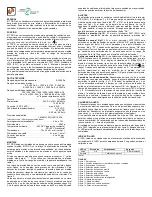
GST
™
43 Thru-Hull
Transducer
Installation Instructions
Important Safety Information
WARNING
See the
Important Safety and Product Information
guide in the
product box for product warnings and other important
information.
CAUTION
Failure to install and maintain this equipment in accordance with
these instructions could result in damage or injury.
Always wear safety goggles, ear protection, and a dust mask
when drilling, cutting, or sanding.
NOTICE
When drilling or cutting, always check what is on the opposite
side of the surface.
This equipment should be installed by a qualified marine
installer.
To obtain the best performance and to avoid damage to your
boat, you must install the Garmin
®
transducer according to these
instructions.
Read all installation instructions before proceeding with the
installation. If you experience difficulty during the installation,
contact Garmin Product Support.
Registering Your Device
Help us better support you by completing our online registration
today. Keep the original sales receipt, or a photocopy, in a safe
place.
1
Go to
2
Sign in to your Garmin account.
Mounting Location Considerations
• On fin-keel vessels
À
, the transducer should be mounted
more than 25 cm (10 in) and less than 75 cm (30 in) in front
of the keel and less than 10 cm (4 in) to the side of the
centerline.
• On full-keel vessels
Á
, the transducer should be mounted at
a slight angle that aims at the bow, not parallel to the
centerline.
• On power boats and hulls with chines
Â
, the transducer
should not be mounted near the edge of sharp hull chines.
• On single-drive boats, the transducer must not be mounted in
the path of the propeller.
• On twin-drive boats, the transducer should be mounted
between the drives, if possible.
• The transducer should be mounted parallel to the bow-stern
axis of your vessel.
• The transducer should be mounted in a location that allows
accessibility to the transducer from the inside of the vessel.
• The transducer should not be mounted behind strakes, struts,
fittings, water intake or discharge ports, or anything that
creates air bubbles or causes the water to become turbulent.
• The transducer should not be mounted in a location where it
might be jarred when launching, hauling, or storing.
• The transducer can cause cavitation that can degrade the
performance of the boat and damage the propeller.
• The transducer must be in clean (non-turbulent) water for
optimal performance.
• If you have a question about the location of the thru-hull
transducer, contact your vessel builder or other owners of
similar vessels for advice.
Tools Needed
• Drill
• 43 mm (1
11
/
16
in.) hole saw
• 52 to 55 mm (2
1
/
16
to 2
3
/
16
in.) hole saw (cored-fiberglass
hull installations)
• Marine sealant
• Silicone grease
• Cable cutter
• Metal file (metal-hull installations)
• Fiberglass cloth and resin (option for sealing a cored-
fiberglass hull)
• 43 mm (1
11
/
16
in.) cylinder, wax, tape, and casting epoxy
(option for sealing a cored-fiberglass hull)
Installing the Thru-Hull Transducer
If you are installing the transducer in a cored-fiberglass hull, you
must first prepare the hull (
Preparing a Cored-Fiberglass Hull
).
1
Use a 43 mm (1
11
/
16
in.) hole saw to cut through the hull at
the mounting location.
2
Insert the thru-hull fitting in the hull.
3
Apply marine sealant to the outer flange of the thru-hull fitting
and tighten the nut by hand.
4
Slide both rubber O-rings onto the plug.
5
Apply silicone grease to the outside of the plug.
6
Using a slow, twisting motion, insert the plug into the thru-hull
fitting.
December 2017
190-01185-02_0C
Содержание GST 43
Страница 4: ...support garmin com ...






















